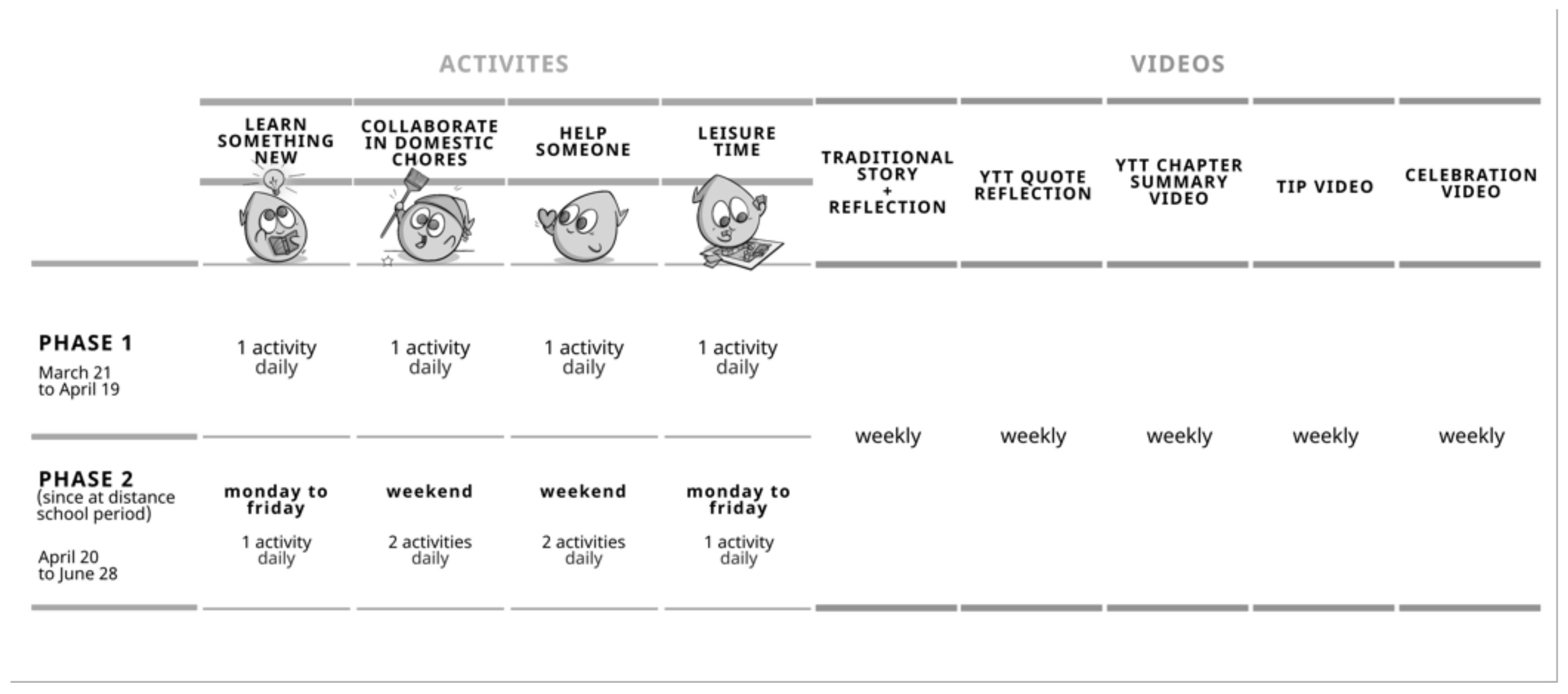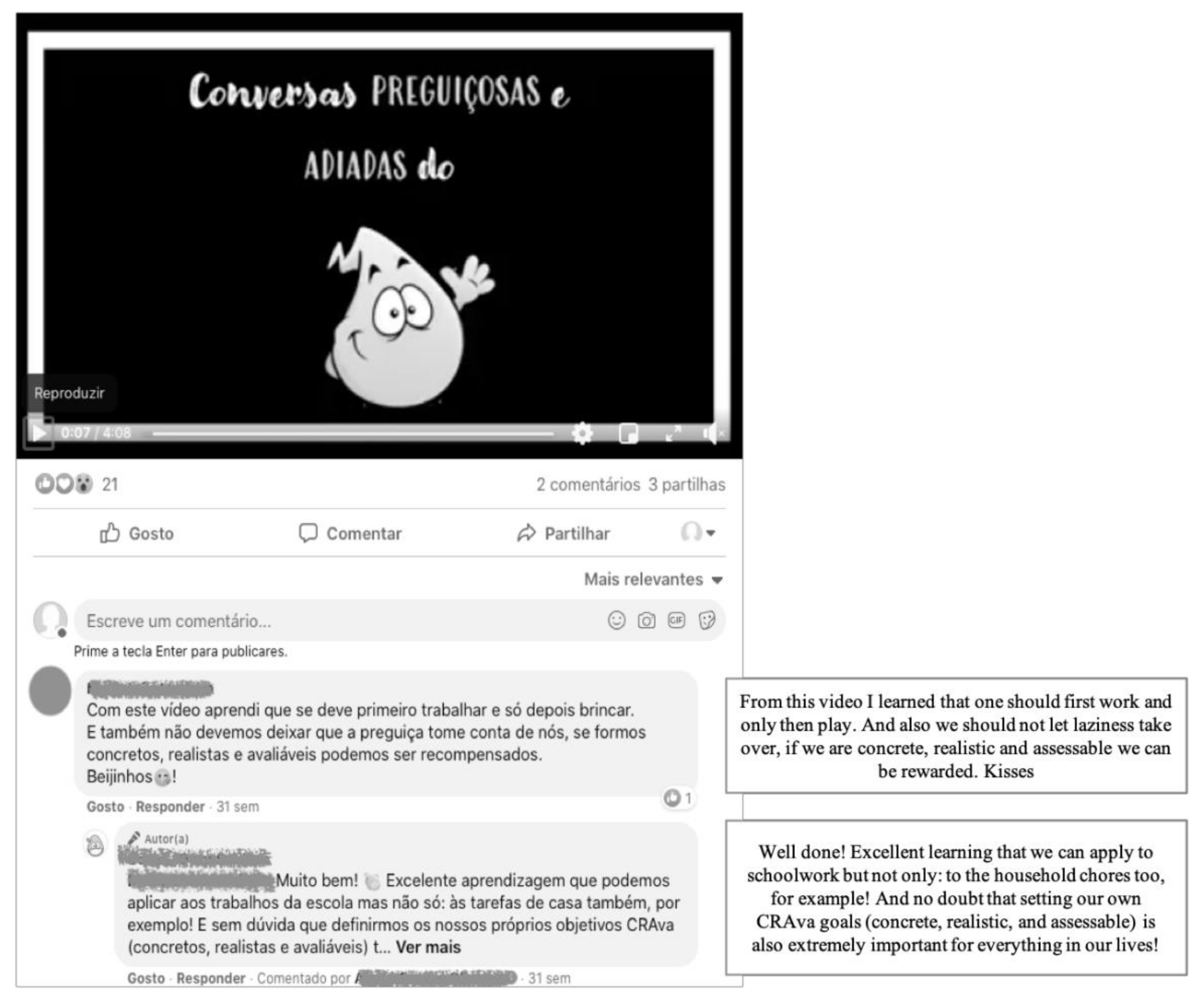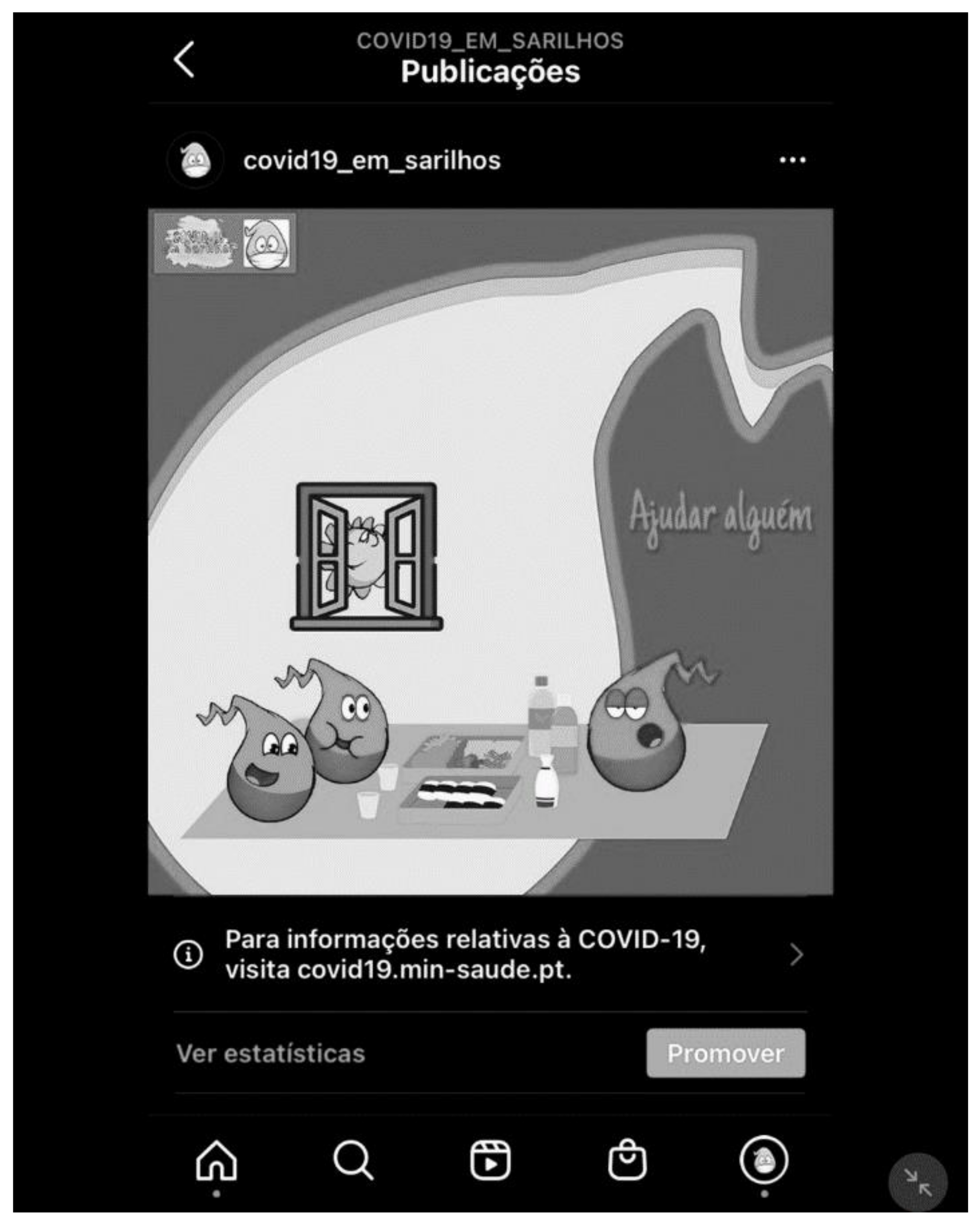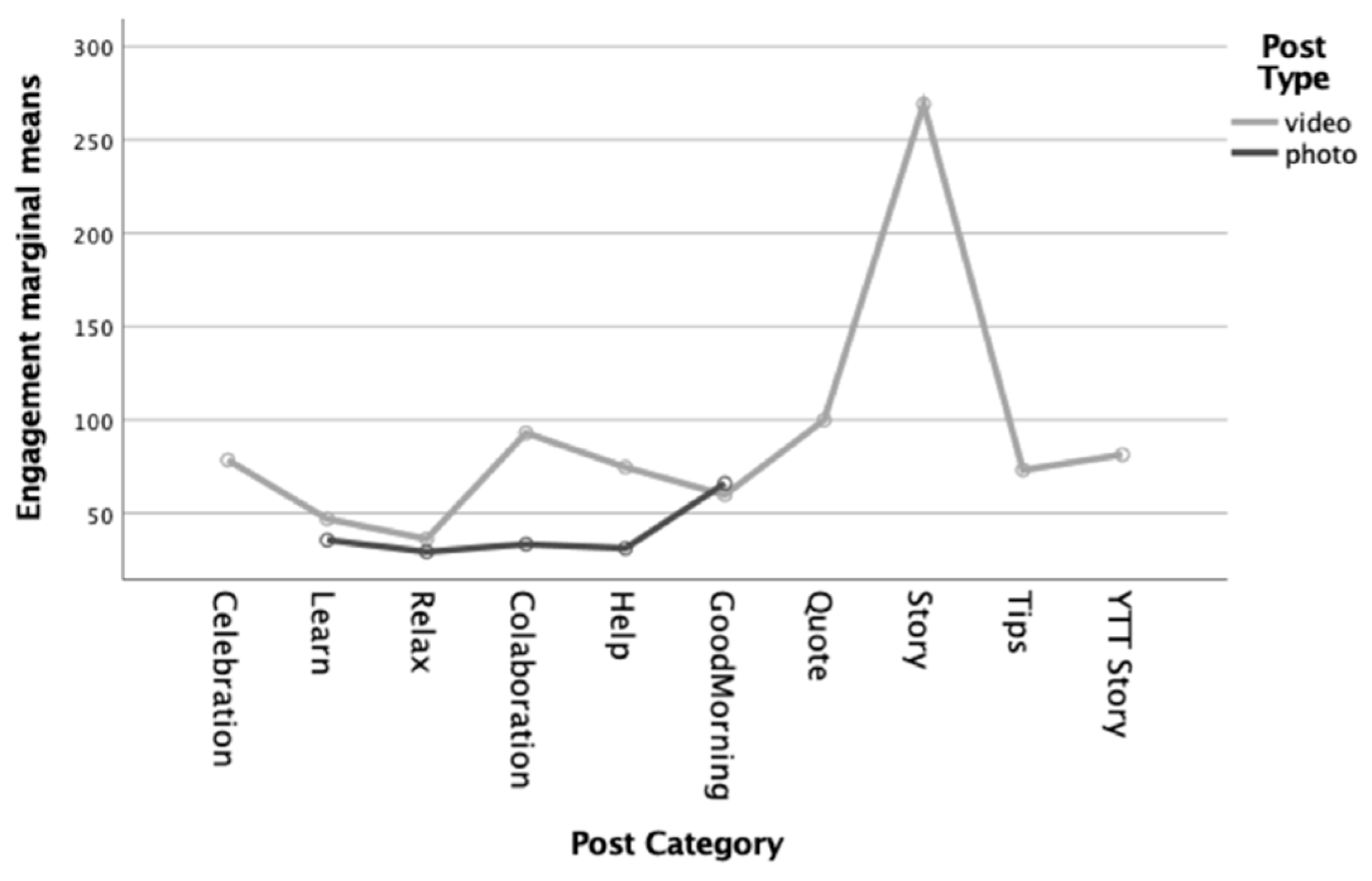“COVID-19 in Trials and Tribulations” Project: A Self-Regulation-Based Support Response for Confined Families through Social Networks
Abstract
:1. Introduction
1.1. Theoretical Framework
1.2. The Present Study
2. Materials and Methods
2.1. Target Population
2.2. COVID-19 in Trials and Tribulations
2.3. Data Collection and Measures
2.3.1. Facebook® and Instagram® Page-Level Information
2.3.2. Facebook® Post Level Information
2.4. Data Analysis
3. Results
3.1. Page-Level Description
3.2. Facebook® Post Level Analysis
4. Discussion
4.1. Implications for Practice: Lessons Learned
4.2. Limitations and Future Studies
5. Conclusions
Author Contributions
Funding
Institutional Review Board Statement
Informed Consent Statement
Acknowledgments
Conflicts of Interest
References
- Presidência da República. Decreto do Presidente da República n.º 14-A/2020; n.º 55/2020, 3º Suplemento, Série I de 2020-03-18; Diário da República: Lisbon, Portugal, 2020; pp. 2–4. Available online: https://data.dre.pt/eli/decpresrep/14-a/2020/03/18/p/dre/pt/html (accessed on 18 January 2022).
- Binder, K.; Crego, M.D.; Eckert, G.; Kotanidis, S.; Manko, R.; Del Monte, M. States of Emergency in Response to the Coronavirus Crisis: Situation in Certain Member States; European Parliament: Strasbourg, France, 2020; p. 12. [Google Scholar]
- Presidência do Conselho de Ministros. Decreto-Lei n.º 14-G/2020; n.º 72/2020, 2º Suplemento, Série I de 2020-04-13; Diário da República: Lisbon, Portugal, 2020; pp. 9–19. Available online: https://data.dre.pt/eli/dec-lei/14-G/2020/04/13/p/dre (accessed on 18 January 2022).
- Presidência do Conselho de Ministros. Resolução do Conselho de Ministros n.º 33-A/2020; n.º 85/2020, 3º Suplemento, Série I de 2020-04-30; Diário da República: Lisbon, Portugal, 2020; pp. 10–21. Available online: https://data.dre.pt/eli/resolconsmin/33-a/2020/04/30/p/dre/pt/html (accessed on 18 January 2022).
- OECD. A Framework to Guide an Education Response to the COVID-19 Pandemic of 2020; OECD Policy Responses to Coronavirus (COVID-19); OECD Publishing: Paris, France, 2020. [Google Scholar] [CrossRef]
- Wang, G.; Zhang, Y.; Zhao, J.; Zhang, J.; Jiang, F. Mitigate the effects of home confinement on children during the COVID-19 outbreak. Lancet 2020, 395, 945–947. [Google Scholar] [CrossRef]
- Dong, C.; Cao, S.; Li, H. Young children’s online learning during COVID-19 pandemic: Chinese parents’ beliefs and attitudes. Child. Youth Serv. Rev. 2020, 118, 105440. [Google Scholar] [CrossRef] [PubMed]
- Rosário, P.; Cunha, J.; Pereira, A.; Guimarães, A.; Vieira, C.; Lopes, D.; Sousa, P. ℌCOVID-19 em Sarilhosℍ: Respostas de intervenção na promoção de competências autorregulatórias em período de pandemia. In A Universidade Do Minho Em Tempos de Pandemia; UMinho Editora: Braga, Portugal, 2020; Volume II, pp. 41–65. [Google Scholar] [CrossRef]
- Zinchenko, Y.P.; Morosanova, V.I.; Kondratyuk, N.G.; Fomina, T.G. Conscious Self-Regulation and Self-organization of Life during the COVID-19 Pandemic. Psychol. Russ. State Art 2020, 13, 168–182. [Google Scholar] [CrossRef]
- Ćosić, K.; Popović, S.; Šarlija, M.; Kesedžić, I. Impact of Human Disasters and COVID-19 Pandemic on Mental Health: Potential of Digital Psychiatry. Psychiatr. Danub. 2020, 32, 25–31. [Google Scholar] [CrossRef] [PubMed]
- Talevi, D.; Socci, V.; Carai, M.; Carnaghi, G.; Faleri, S.; Trebbi, E.; di Bernardo, A.; Capelli, F.; Pacitti, F. Mental health outcomes of the COVID-19 pandemic. Riv. Psichiatr. 2020, 55, 137–144. [Google Scholar] [CrossRef]
- Brooks, S.K.; Webster, R.K.; Smith, L.E.; Woodland, L.; Wessely, S.; Greenberg, N.; Rubin, G.J. The psychological impact of quarantine and how to reduce it: Rapid review of the evidence. Lancet 2020, 395, 912–920. [Google Scholar] [CrossRef] [Green Version]
- Hou, W.K.; Lai, F.T.; Ben-Ezra, M.; Goodwin, R. Regularizing daily routines for mental health during and after the COVID-19 pandemic. J. Glob. Health 2020, 10, 020315. [Google Scholar] [CrossRef] [PubMed]
- Liu, D.; Wright, K.B.; Hu, B. A meta-analysis of Social Network Site use and social support. Comput. Educ. 2018, 127, 201–213. [Google Scholar] [CrossRef]
- Rosário, P.; Núñez, J.C.; Fuentes, S. Sarilhos do Amarelo; Porto Editora: Porto, Portugal, 2007. [Google Scholar]
- Bandura, A. Toward a Psychology of Human Agency. Perspect. Psychol. Sci. A J. Assoc. Psychol. Sci. 2006, 1, 164–180. [Google Scholar] [CrossRef]
- Rosário, P.; Núñez, J.C.; Rodríguez, C.; Cerezo, R.; Fernández, E.; Tuero, E.; Högemann, J. Analysis of instructional programs in different academic levels for improving self-regulated learning through written text. In Design Principles for Teaching Effective Writing; Fidalgo, R., Harris, K.R., Braaksma, M., Eds.; Brill: Leiden, The Netherlands, 2017; Volume 34, pp. 201–230. [Google Scholar]
- Bandura, A. The evolution of social cognitive theory. In Great Minds in Management; Smith, K.G., Hitt, M.A., Eds.; Oxford University Press: Oxford, UK, 2005; pp. 9–35. [Google Scholar]
- Zimmerman, B.J. Attaining self-regulation: A social cognitive perspective. In Handbook of Self-Regulation; Boekaerts, M., Pintrich, P.R., Zeidner, M., Eds.; Academic Press: Cambridge, MA, USA, 2000; pp. 13–39. [Google Scholar] [CrossRef]
- Zimmerman, B.J. Becoming a Self-Regulated Learner: An Overview. Theory Into Pract. 2002, 41, 64–70. [Google Scholar] [CrossRef]
- Rosário, P.; Núñez, J.; Magalhães, P.; Fuentes, S.; Magalhães, C.; Busing, K. Improving College Students’ Critical Thinking through the use of a Story Tool for Self-Regulated Learning Training. In Deeper Learning, Dialogic Learning, and Critical Thinking, 1st ed.; Manalo, E., Ed.; Routledge: London, UK, 2019; pp. 193–208. [Google Scholar]
- de Boer, H.; Donker, A.S.; Kostons, D.D.; van der Werf, G.P. Long-term effects of metacognitive strategy instruction on student academic performance: A meta-analysis. Educ. Res. Rev. 2018, 24, 98–115. [Google Scholar] [CrossRef] [Green Version]
- Rosário, P.; Núñez, J.C.; Vallejo, G.; Cunha, J.; Azevedo, R.; Pereira, R.; Nunes, A.R.; Fuentes, S.; Moreira, T. Promoting Gypsy children school engagement: A story-tool project to enhance self-regulated learning. Contemp. Educ. Psychol. 2016, 47, 84–94. [Google Scholar] [CrossRef]
- Fernández, E.; Bernardo, A.; Suárez, N.; Cerezo, R.; Núñez, J.C.; Rosário, P. Predicción del uso de estrategias de autorregulación en educación superior. An. Psicol. 2013, 29, 865–875. [Google Scholar] [CrossRef] [Green Version]
- Zimmerman, B.J.; Schunk, D.H. An essential dimension of self-regulated learning. Motiv. Self-Regul. Learn. Theory Res. Appl. 2008, 1, 1–30. [Google Scholar]
- Greenhow, C.; Galvin, S.M.; Staudt Willet, K.B. What Should Be the Role of Social Media in Education? Policy Insights Behav. Brain Sci. 2019, 6, 178–185. [Google Scholar] [CrossRef]
- INE. Instituto Nacional de Estatística—Statistics Portugal. Available online: https://www.ine.pt/xportal/xmain?xpid=INE&xpgid=ine_destaques&DESTAQUESdest_boui=281440779&DESTAQUESmodo=2&xlang=pt (accessed on 15 December 2021).
- INE. Instituto Nacional de Estatística—Statistics Portugal. Available online: https://www.ine.pt/xportal/xmain?xpid=INE&xpgid=ine_destaques&DESTAQUESdest_boui=354447153&DESTAQUEStema=55565&DESTAQUESmodo=2 (accessed on 15 December 2021).
- INE. Instituto Nacional de Estatística—Statistics Portugal. Available online: https://www.ine.pt/xportal/xmain?xpid=INE&xpgid=ine_destaques&DESTAQUESdest_boui=467501482&DESTAQUESmodo=2 (accessed on 15 December 2021).
- Grupo Marktest. Os Portugueses e as Redes Sociais 2020; Marktest Consulting: Lisboa, Portugal, 2020; Available online: https://www.marktest.com/wap/private/images/Logos/Folheto_Portugueses_Redes_Sociais_2020.pdf (accessed on 18 January 2022).
- Van-Marketing & Digital. Available online: https://van.pt/redes-sociais-usadas-portugal/ (accessed on 18 January 2022).
- PORDATA. Agregados Domésticos Privados, Por Grupo Etário do Representante da Família. Available online: https://www.pordata.pt/Portugal/Agregados+domésticos+privados++por+grupo+etário+do+representante+da+fam%C3%ADlia-821 (accessed on 15 December 2021).
- Pletikosa Cvijikj, I.; Michahelles, F. Online engagement factors on Facebook brand pages. Soc. Netw. Anal. Min. 2013, 3, 843–861. [Google Scholar] [CrossRef]
- UNESCO. Adverse Consequences of School Closures. Available online: https://en.unesco.org/covid19/educationresponse/consequences (accessed on 15 December 2021).
- Rosário, P.; Núñez, J.C.; Vallejo, G.; Nunes, T.; Cunha, J.; Fuentes, S. Homework purposes, homework behaviors, and academic achievement. Examining the mediating role of students’ perceived homework quality. Contemp. Educ. Psychol. 2018, 53, 168–180. [Google Scholar] [CrossRef] [Green Version]
- Carter, R.A., Jr.; Rice, M.; Yang, S.; Jackson, H.A. Self-regulated learning in online learning environments: Strategies for remote learning. Inf. Learn. Sci. 2020, 121, 321–329. [Google Scholar] [CrossRef]
- Inan, F.; Yukselturk, E.; Kurucay, M.; Flores, R. The impact of self-regulation strategies on student success and satisfaction in an online course. Int. J. E-Learn. 2017, 16, 23–32. [Google Scholar]
- Regueiro, R.; Suárez, N.; Valle, A.; Núñez, J.C.; Rosário, P. Homework motivation and engagement throughout compulsory education. Rev. Psicodidáctica 2015, 20, 47–73. [Google Scholar] [CrossRef] [Green Version]
- IBM Corp. IBM SPSS Statistics (Version 24.0); Windows; IBM Corp.: Armonk, NY, USA, 2016. [Google Scholar]
- Gupta, A.; Yousaf, A.; Agrawal, A. Like it but do not comment: Manipulating the engagement of sports fans in social media. Int. J. Sport Manag. Mark. 2018, 18, 340. [Google Scholar] [CrossRef]
- Bayrakdar, S.; Guveli, A. Inequalities in home learning and schools’ provision of distance teaching during school closure of COVID-19 lockdown in the UK. In ISER Working Paper Series; Working paper (No. 2020-09); Institute for Social & Economic Research, Economic and Social Research Council, University of Essex: Colchester, UK, 2020; Available online: https://www.iser.essex.ac.uk/research/publications/working-papers/iser/2020-09.pdf (accessed on 15 December 2021).
- Lin, K.C.; Lee, I.C.; Cheng, C.F.; Hung, H.C. The Effects of Adopting Tablets and Facebook for Learning Badminton Skills: A Portfolio-Based WISER Model in Physical Education. J. Educ. Technol. Soc. 2020, 23, 89–105. [Google Scholar]
- Yu, A.Y.; Tian, S.W.; Vogel, D.; Chi-Wai Kwok, R. Can learning be virtually boosted? An investigation of online social networking impacts. Comput. Educ. 2010, 55, 1494–1503. [Google Scholar] [CrossRef]




| M (SD) | Min | Max | |
|---|---|---|---|
| Facebook® N = 14 weeks | |||
| Likes | 328.79 (629.70) | 17 | 2362 |
| Unlikes | 11.50 (18.75) | 2 | 73 |
| Total Engagement | 9787.50 (4356.40) | 5558 | 17,648 |
| Total Reach | 83,888.50 (39,232.46) | 44,660 | 158,228 |
| Total Viral Reach | 55,899.86 (25,090.13) | 30,590 | 118,531 |
| Total Consumption | 14,090.36 (3743.14) | 10,325 | 21,848 |
| Total Video Views | 58,837.07 (20,933.13) | 32,271 | 104,065 |
| Total Video Repeat | 27,525.71 (5988.34) | 11,789 | 34,357 |
| Instagram® N = 14 weeks | |||
| Followers | 1132 (135.60) | 836 | 1247 |
| Unfollowers | 7.43 (10.46) | 0 | 38 |
| Total Engagement | 1613.50 (2172.14) | 881 | 9147 |
| Total Consumption | 543.29 (338.62) | 188 | 1279 |
| Total Video Views | 33,966.43 (32,608.60) | 471 | 81,255 |
| Post Type | ||||||
|---|---|---|---|---|---|---|
| Total nr. of Posts | Video | Photo | ||||
| T1 | T2 | Mean Engagement T1 | Mean Engagement T2 | Mean Engagement T1 | Mean Engagement T2 | |
| Category: Daily | ||||||
| LSN a | 31 | 54 | 62.50 | 31.32 | 39.43 | 31.74 |
| CDC b | 29 | 47 | 93.00 | -- | 35.18 | 31.60 |
| HS c | 32 | 48 | 114.60 | 34.60 | 32.85 | 29.50 |
| LT d | 28 | 54 | 42.50 | 29.93 | 31.96 | 26.67 |
| GM e | 0 | 39 | -- | 59.79 | -- | 66.00 |
| Tips | 0 | 2 | -- | 57.00 | -- | -- |
| Category: Weekly | ||||||
| Quote | 4 | 10 | 129.00 | 70.90 | -- | -- |
| Story | 3 | 18 | 444.33 | 98.00 | -- | -- |
| Tips | 10 | 8 | 72.40 | 90.00 | -- | -- |
| YTT Story | 4 | 6 | 112.00 | 50.67 | -- | -- |
| Celebration | 4 | 10 | 95.25 | 62.70 | -- | -- |
Publisher’s Note: MDPI stays neutral with regard to jurisdictional claims in published maps and institutional affiliations. |
© 2022 by the authors. Licensee MDPI, Basel, Switzerland. This article is an open access article distributed under the terms and conditions of the Creative Commons Attribution (CC BY) license (https://creativecommons.org/licenses/by/4.0/).
Share and Cite
Pereira, A.; Magalhães, P.; Teixeira, S.; Núñez, J.C.; Rosendo, D.; Mesquita, S.; Azevedo, R.; Martins, J.A.; Fuentes, S.; Rosário, P. “COVID-19 in Trials and Tribulations” Project: A Self-Regulation-Based Support Response for Confined Families through Social Networks. Int. J. Environ. Res. Public Health 2022, 19, 1910. https://doi.org/10.3390/ijerph19031910
Pereira A, Magalhães P, Teixeira S, Núñez JC, Rosendo D, Mesquita S, Azevedo R, Martins JA, Fuentes S, Rosário P. “COVID-19 in Trials and Tribulations” Project: A Self-Regulation-Based Support Response for Confined Families through Social Networks. International Journal of Environmental Research and Public Health. 2022; 19(3):1910. https://doi.org/10.3390/ijerph19031910
Chicago/Turabian StylePereira, Armanda, Paula Magalhães, Sara Teixeira, José Carlos Núñez, Daniela Rosendo, Sandra Mesquita, Raquel Azevedo, Joana Araújo Martins, Sonia Fuentes, and Pedro Rosário. 2022. "“COVID-19 in Trials and Tribulations” Project: A Self-Regulation-Based Support Response for Confined Families through Social Networks" International Journal of Environmental Research and Public Health 19, no. 3: 1910. https://doi.org/10.3390/ijerph19031910
APA StylePereira, A., Magalhães, P., Teixeira, S., Núñez, J. C., Rosendo, D., Mesquita, S., Azevedo, R., Martins, J. A., Fuentes, S., & Rosário, P. (2022). “COVID-19 in Trials and Tribulations” Project: A Self-Regulation-Based Support Response for Confined Families through Social Networks. International Journal of Environmental Research and Public Health, 19(3), 1910. https://doi.org/10.3390/ijerph19031910









